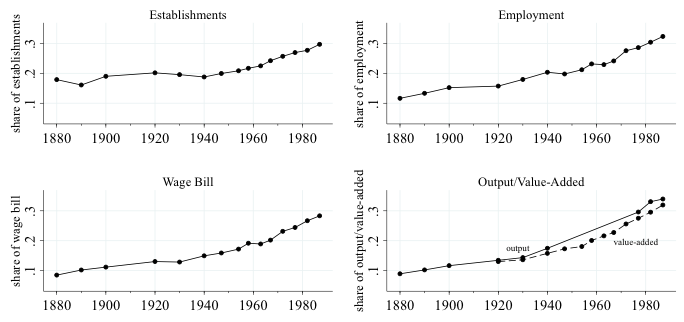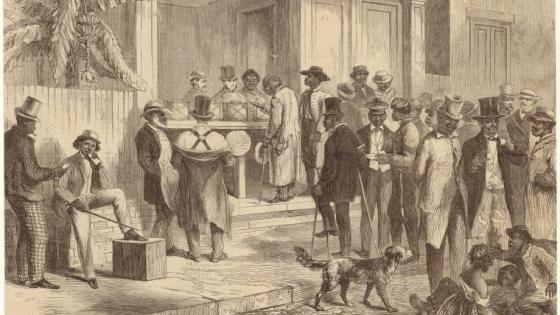The aftermath of the Great Recession brought WWII back into the spotlight, as policymakers looked for historical analogies to inform their response to the crisis.1 At the time, the debate focused on the lessons to be learned regarding the role of government stimulus in economic recovery. Another issue that has emerged in the decade since is what role the government has for an economy in transition, or when some regional economies are lagging behind others. Here too, the experience of the US during WWII can be instructive.
Mobilisation for WWII was a massive undertaking. The government spent $108 billion on supply contracts to arm Allied Forces around the world, while at home, investment in equipment and the construction of new factories totalled $26 billion. Looking back after the war, many observers saw a production miracle that served as the ‘arsenal of democracy’ in the 1940s. They also saw recovery from the Great Depression and speculated about potential positive effects on industries and regions into the future. This was particularly true in the context of the American South, where industrial development prior to 1940 appeared stymied and the economy stagnant.2
With respect to the link between southern industrialisation and WWII, the consensus view that emerged in the immediate post-war period can be summarised as follows: before 1940 the barriers to industrialisation were slow to erode, and the shock of mobilisation allowed new investment to flow to industries starved of capital but ready for growth. Indeed, aggregate evidence suggests that new investment nearly doubled the regions’ capital stock and, as shown in Figure 1, increased its share of manufacturing activity. Yet, this evidence alone is not enough to conclude that war-related investment played a decisive role in southern industrialisation.
Figure 1 Trends in the share of manufacturing activity in the US South, 1880-1987
Notes: The panels of the figure show the share of establishments, employment, wage bill, and output/value-added located in the US South, which includes Alabama, Arkansas, Delaware, Florida, Georgia, Kentucky, Louisiana, Maryland, Mississippi, North Carolina, Oklahoma, South Carolina, Tennessee, Texas, Virginia, West Virginia, and the District of Columbia.
In recent research, I revisit the hypothesis that war-related investment increased local manufacturing activity using newly collected data (Jaworski 2017). In my empirical analysis, I distinguish investment in structures from investment in equipment or spending on supply contracts in order to focus on the role of the large capital shock to the region that is emphasised in the historical literature. Theoretically, if the fixed costs of adopting modern industrial technology held back Southern industrialisation, then the size and coordination of new investment during WWII may have helped to overcome this barrier. Empirically, the difficulty is separating the impact of wartime investment from its placement in counties that were already industrialised or that had other characteristics conducive to the growth of manufacturing.
My results provide a corrective to earlier empirical work that was too optimistic in attributing the post-war growth in manufacturing to wartime investment. Figure 2 illustrates the main findings of the analysis. The figure shows estimated coefficients for the impact of wartime investment on four manufacturing outcomes: establishments, employment, wage bill, and value-added. In each case, there is no clear evidence of a change in manufacturing activity associated with receiving more wartime investment.
Figure 2 Impact of WWII investment on manufacturing activity in US South, 1920-1987
Notes: In each panel, the solid black line shows estimated coefficients on WWII investment from a regression that also includes county fixed effects, state-year fixed effects, and additional county level control variables (interacted with year fixed effects). The dashed black lines show the 95% confidence interval based on standard errors clustered at the state level.
I also consider several alternative specifications of the regression underlying these estimates and take different approaches to addressing variation in the policy environment, such as New Deal policies discussed by Kitchens (2014) and Kline and Moretti (2014), or state policies for industrial recruitment discussed by Holmes (1998). Taken together, the evidence does not support a decisive role for wartime capital deepening on the South’s post-war industrial development.
The literature offers several potential explanations for this finding. Wartime investment may have had limited usefulness in post-war, non-military production, or been utilised to the point of near complete depreciation as a result of two- or three-shift runs (Higgs 2006, Field 2011, Rockoff 2012). Indeed, my own tabulations and those of White (1980) suggest substantial discounts were applied to the sale of surplus property in the post-war period. This is also in line with evidence from Ramey and Shapiro (2001) for demobilisation from the Cold War in the aerospace industry.
This does not rule out positive effects of WWII investment in some cases. For example, Cobb County in Georgia received a Bell Aircraft plant and this appears to have been associated with gains in manufacturing relative to other counties in Georgia that received some investment and those that received none. But the post-war history of the Bell Aircraft plant is closely related to the emergence of the military-industrial complex and not the one-off mobilisation of the county’s industry and population for WWII.
Together, these findings leave at least two questions open to future investigation. First, how valuable was WWII investment once it was deployed to private uses in the post-war period? Second, what was the role of subsequent government spending as part of the Cold War on local economic development? Previous research provides some guidance on these questions, but more needs to be done to understand the institutions created to manage demobilisation and their impact on the development of US industries and regions.
References
Barro, R (2009), “Government spending Is no free lunch”, Wall Street Journal. 22 January.
Eichengreen, B (2012), “Economic history and economic policy”, Journal of Economic History 71(2): 289-307.
Eichengreen, B (2015), Hall of Mirrors: The Great Depression, the Great Recession, and the Uses—and Misuses—of History, Oxford: Oxford University Press.
Field, A J (2011), A Great Leap Forward: 1930s Depression and US Economic Growth, New Haven, CT: Yale University Press.
Higgs, R (2006), “Private profit, public risk: Institutional antecedents of the modern military procurement system in the rearmament program of 1940-41”, in R Higgs (ed), Depression, War, and Cold War: Studies in Political Economy, Oxford: Oxford University Press.
Holmes, T (1998), “The effect of state policies on the location of manufacturing: Evidence from state borders”, Journal of Political Economy 106(4): 667-705.
Jaworski, T (2017), “World War II and the industrialization of the American South”, NBER Working Paper 23477.
Kitchens, C (2014) “The role of publicly provided electricity in economic development: The experience of the Tennessee Valley Authority, 1929-1955”, Journal of Economic History 74(2): 389-419.
Moretti, E and P Kline (2014), “Local economic development, agglomeration economies and the Big Push: 100 years of evidence from the Tennessee Valley Authority”, Quarterly Journal of Economics 129(1): 275-331.
Ramey, V A and M D Shapiro (2001), “Displaced capital: A study of aerospace plant closings”, Journal of Political Economy 109(5): 958–992.
Rockoff, H (2012), America’s economic way of war: War and the US economy from the Spanish-American war to the Persian Gulf War, Cambridge, UK: Cambridge University Press.
Romer, C (2011), “The hope that flows from history”, New York Times, 13 August.
White, G T (1980), Billions for Defense: Government Finance by the Defense Plant Corporation During World War II, University, AL: University Alabama Press.
Endnotes
[1] See Barro (2009) and Romer (2011) for contrasting views. Eichengreen’s Presidential Address to the Economic History Association (Eichgreen 2012) and 2015 book, Hall of Mirrors, examine the application of analogies from the Great Depression to the recent financial crisis.
[2] In a speech on 4 July 4 1938, President Franklin Roosevelt declared the South “the nation’s number one economic problem.” Even before the War was over, one commentator had reversed this view—“The South… in January 1945 was no longer the nation’s number one economic problem.”





